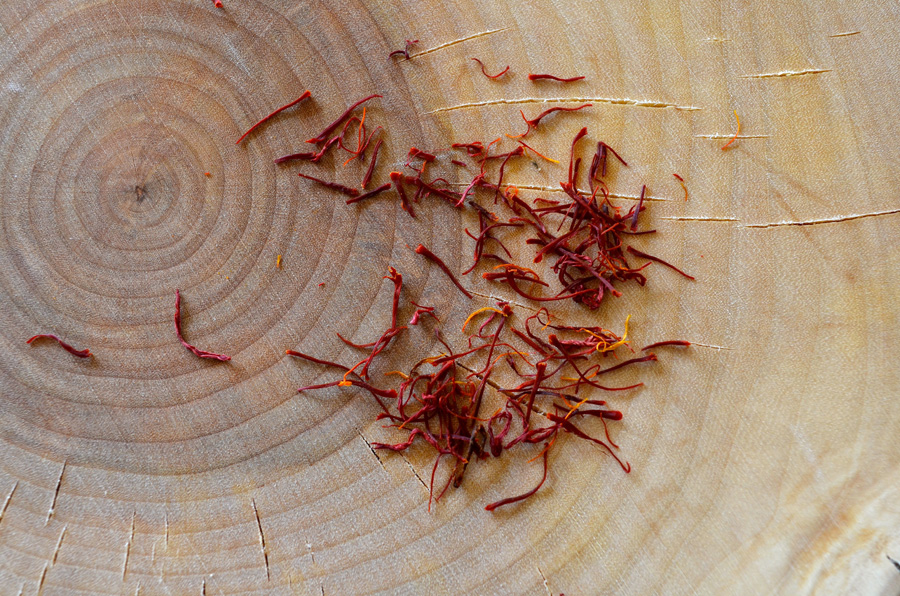Azafrán

Saffron threads
Dishes such as paella would not be possible, or at least complete, without a pinch of saffron, the most expensive spice on the planet. Saffron is a spice derived from the three stigmas of the flower of Crocus sativus, commonly known as the “saffron crocus”. The styles and stigmas, called threads, are collected and dried to be used mainly as a seasoning and coloring agent in food.

Crocus sativus, saffron flower
The price of saffron is justified when you consider its yield and its labor-intensive production. Each plant grows just one flower, and each flower has three stigmas. In order to collect 1 kilogram of saffron you will need the threads of some 250,000 flowers.

Harvesting saffron flowers
Moreover, the harvesting and collection of the threads is done entirely by hand. Harvest happens between late October and early November, when the flowers, called in Spanish rosas del azafrán, are in full bloom. Roses are handpicked at dawn and brought in baskets to nearby villages, where women carefully pluck out their stigmas by hand.
From there, the stigmas are brought to facilities where they will be further “purified” by removing any dust or flower remains, before they’re stored to dry.

Hand-pluckling saffron threads
Archeological findings place the first known references to saffron and its uses in the 7th century b.C., and saffron based pigments have been found in 50,000 year old depictions in Persia (current Iran). From there, cultivation and use of saffron spread, mostly from East to West, and it might have arrived in China with mongol invaders from Persia.
It was highly valued by the Romans, who introduced it to France during the Roman Empire. In Spain, it was introduced by the Moors towards the end of the X century. Its use grew during the Middle Ages, and in fact for centuries it was the most often used spice in Catalonian cuisine (due mainly to the fact that it was the only one that didn’t have to be imported). From Spain, saffron might have spread to England in the XIV century through Christian Europe, although the introduction of more exotic spices like vanilla or tea relegated its cultivation and use in England.

Today, Spain is the second highest saffron producing country in the world, and it’s considered by many as the finest due to its high concentration of flavoring and aromatic oils. Its cultivation is mostly concentrated in Catalonia, Aragón, and La Mancha, in central Spain. In fact, saffron of La Mancha has a DO, Denominación de Origen, the highest standard of quality.
Even though saffron has had many uses throughout history—from medicinal, to cosmetic, to textile—, saffron in Spain has mainly a culinary use. Most rice dishes, soups and stews, benefit from a pinch of saffron, both in taste and in color, and it’s even used in desserts.

Saffron can be bought and used both in its thread form and in powder form. The threads are more stable, and can be stored in a cool, dark place for about two years.
 Powder saffron has to be used within six months. Moreover, it is more susceptible to being adulterated with other colorings (a good way to find out is to dissolve a pinch of it in an ounce of warm liquid: if it colors it immediately, the saffron has probably been adulterated with colorings, because real saffron takes a few minutes to tint the liquid). Beware, then, of inexpensive powdered saffron. However, because dishes only need a small pinch of it (add too much and your food will become too bitter), a small box of the more expensive, pure saffron, will go a long way. To use it, simply crush it in a mortar and dissolve it in a bit of warm liquid (water, broth or milk) before adding it to your dish.
Powder saffron has to be used within six months. Moreover, it is more susceptible to being adulterated with other colorings (a good way to find out is to dissolve a pinch of it in an ounce of warm liquid: if it colors it immediately, the saffron has probably been adulterated with colorings, because real saffron takes a few minutes to tint the liquid). Beware, then, of inexpensive powdered saffron. However, because dishes only need a small pinch of it (add too much and your food will become too bitter), a small box of the more expensive, pure saffron, will go a long way. To use it, simply crush it in a mortar and dissolve it in a bit of warm liquid (water, broth or milk) before adding it to your dish.
I usually bring saffron from Spain, but when I run out, I like to use this one (click on the link):
Photo credits
©Natacha Sanz-Caballero, Azafrán de La Mancha Atalaya, región de Murcia digital

